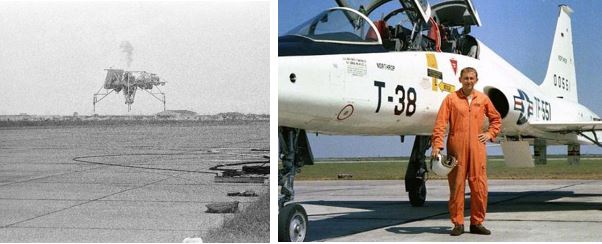The Lunar Landing Training Vehicle #1 (LLTV-1) made its first flight on October 3, 1968, at Ellington Air Force Base near the Manned Spacecraft Center (MSC), now the Johnson Space Center, in Houston. MSC Aircraft Operations Office Chief Joseph S. “Joe” Algranti piloted the LLTV during this maiden flight, which lasted eight minutes and reached an altitude of 50 feet. During the next two months, Algranti and fellow NASA pilot H.E. “Bud” Ream completed 14 test flights with LLTV-1 to check out the vehicle.
Critical to the lunar program, the LLTV allowed Apollo astronauts to master the intricacies of landing on the Moon by simulating the Lunar Module’s (LM) performance. Bell Aerosystems of Buffalo, New York, built the LLTV and its predecessor the Lunar Landing Research Vehicle (LLRV). The LLTVs were overall similar to the LLRVs, and provided more accurate simulations of the LM’s flying characteristics. The two LLRVs completed a thorough testing program at Dryden Flight Research Center, now Armstrong Flight Research Center, in California, between 1964 and 1967. Following the test program, NASA transferred them to Ellington, where LLRV-1 completed 84 flights and LLRV-2 was kept as a reserve vehicle. The first LLTV arrived at Ellington in October 1967, followed by two more vehicles in
While important for the astronauts’ lunar landing training, that training was not without risk. In May 1968, LLRV-1 suddenly went out of control and crashed. Astronaut Neil Armstrong, the pilot during that test, safely ejected. In response, NASA grounded the fleet and established an accident review board. A final report, issued on October 17, cited a loss of helium pressure that caused depletion of the fuel used for the reserve attitude thrusters. Contributing to the problem was inadequate warning to the pilot, who had no time to respond to the loss of attitude. Appropriate modifications were made to LLRVs and LLTVs before they were cleared to fly. In a second incident, Algranti was piloting LLTV-1 on its 15th flight on December 8 that same year, when undetected wind shear exceeded the vehicle’s aerodynamic control limits. The vehicle crashed, but Algranti ejected to safety. Just three days earlier, Ream had successfully completed the first test flight of LLTV-2. Once again, NASA grounded the remaining LLTVs as an investigative board sought to determine the root causes and whether any vehicle modifications were required before flights could resume. To better understand the vehicle’s aerodynamic characteristics, NASA engineers tested LLTV-3 in the wind tunnel at the Langley Research Center in Virginia. Management cleared Armstrong to fly LLTV-2 in June 1969, and he completed his final training flight just three weeks prior to the Apollo 11 mission. Armstrong completed 21 flights in the LLRV and 6 in the LLTV, valuable experience that he credits with being able to successfully guide the LM Eagle to the lunar surface on July 20, 1969, meeting President John F. Kennedy’s goal of landing a man on the Moon before the end of the decade.
Read Algranti’s oral history with the JSC History Office. For additional first-hand accounts, also read oral histories with Charles R. Haines, LLTV Program Manager in the Aircraft Operations Office between 1969 and 1973, and Donald L. Mallick, chief project pilot on the LLRV at Dryden, who also helped develop the procedures used in the lunar landing.
For more on LLRVs and LLTVs, read https://www.hq.nasa.gov/alsj/LLRV_Monograph.pdf



























